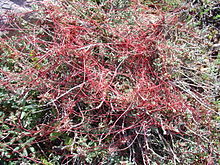Cuscuta epithymum
| Cuscuta epithymum | |
|---|---|

| |
| Scientific classification | |
| Kingdom: | Plantae |
| Clade: | Tracheophytes |
| Clade: | Angiosperms |
| Clade: | Eudicots |
| Clade: | Asterids |
| Order: | Solanales |
| Family: | Convolvulaceae |
| Genus: | Cuscuta |
| Species: | C. epithymum
|
| Binomial name | |
| Cuscuta epithymum | |
| Synonyms | |
|
Lepimenes epithymum (L.) Raf.[3] | |
Cuscuta epithymum (dodder, lesser dodder, hellweed, strangle-tare) is a parasitic plant assigned to the
androecium
welded to the corolla.
In Eurasia, this species of dodder would often attach itself to the Conehead thyme (Thymus capitatus), taking on the plant's pungency and from whence it also derived its host's Arabic name, al-ṣaʿitrah.[6] During medieval times, dodder was often used as a medicinal cure in treating depression, but causes thirst and dryness of the mouth when consumed.[6]
References
- ^ "Systema vegetabilium ed 13". Linnean Collections. 1774. p. 140. Retrieved 14 July 2018.
- ^ "IPNI Cuscuta epithymum". International Plant Name Index. Retrieved 14 July 2018.
- ^ Govaerts, R.; et al. (2018). "Plants of the World online Cuscuta epithymum". Board of Trustees of the Royal Botanic Gardens, Kew. Retrieved 14 July 2018.
- ^ "APNI Cuscuta epithymum". Australian Plant Name Index. Retrieved 14 July 2018.
- ^ Linnaeus, C. (1753) Species Plantarum 1: 124
- ^ OCLC 607157392)
External links
 Media related to Cuscuta epithymum at Wikimedia Commons
Media related to Cuscuta epithymum at Wikimedia Commons Data related to Cuscuta epithymum at Wikispecies
Data related to Cuscuta epithymum at Wikispecies
